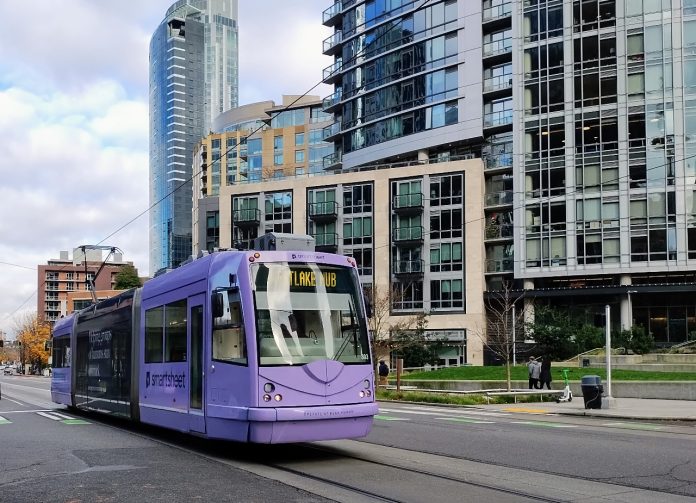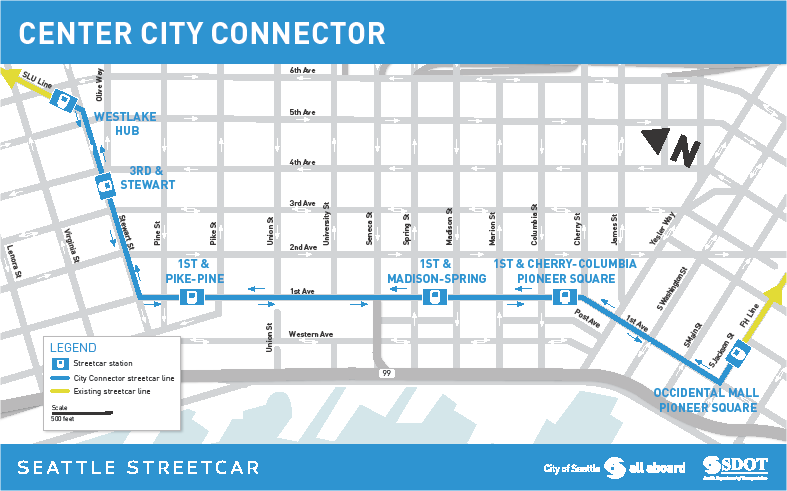
The City of Seattle is officially on track to return $7.3 million in grant funding that had originally been awarded to the Cultural Connector Streetcar, formerly called the Center City Connector, after a local match to advance project plans was not included in the City’s 2024 budget. The impending return of funds was previously reported by The Urbanist in October, but did not come up during council budget deliberations this fall either in briefings by the Seattle Department of Transportation (SDOT) or the city council’s independent staff.
Confirmation that the funding would be reallocated to other projects came at this week’s meeting of the Puget Sound Regional Council’s Federal Transit Administration (FTA) caucus, which meets regularly to discuss timelines for grant-funded transit projects and approve extensions. The two total grants for the Seattle streetcar project, awarded through PSRC via the FTA’s Congestion Mitigation and Air Quality Program, had originally been earmarked for acquisition of new streetcar vehicles. But with the project’s substantial delays, the regional planning organization approved a switch, allowing the funds to instead be used to update the streetcar’s design plans.
But that plan required Seattle to provide a local match to fund design, and without it the grant timeline could not be extended any longer.
“The city council and the mayor passed a budget that did not include that funding,” SDOT planner Chris Eilerman told the FTA caucus Wednesday. “March 2024 was the deadline that we were looking to have that funding obligated with the local match. Based on the budget process we’re not going to be able to meet that deadline… it’s our expectation that that money will get reprogrammed.”
Other projects in the region that had been in line for contingency funds will likely see those dollars come to them — likely outside Seattle.

Mayor Bruce Harrell had included a $1 million local allocation for the streetcar in his proposed supplemental budget for 2023, but a city council committee stripped it out, with no other use for the funding provided. The councilmember who cast the deciding vote at that time, Sara Nelson, joined with streetcar opponents Alex Pedersen and Lisa Herbold and framed her vote as wanting the council to have a full discussion of the streetcar’s merits at a future time.
At the time, SDOT said that it was working on completing a “delivery assessment” for the project that would update assumptions around the project, including total cost. To date, that assessment has still not been released publicly, with SDOT spokesperson Mariam Ali telling The Urbanist that the department expects to release it soon.
“We do need to find out how much this will cost, but we also need to have the policy discussion about this project in itself,” Nelson said ahead of her vote to remove funding this summer. “For a mid-year supplemental [budget], that cost of a million dollars, I think could be allocated in the fall, and we could have a more robust conversation about this.”
That conversation never happened, and even if the incoming city council decides to allocate funding next fall, it will be too late to retain these two grants. The project had a supporter in SDOT Director Greg Spotts, who had been regularly talking up the streetcar project and popularized the cultural connector concept, but that wasn’t enough to get an allocation this fall.
The streetcar, which would finally connect the city’s two disconnected lines with service between two popular tourist districts, has a long history of fits and starts. Construction of the project had originally been set to start in 2018, taking advantage of a short window before full work on the central waterfront redevelopment and demolition of the Alaskan Way viaduct disrupted other nearby downtown streets. Early preparatory work had even begun in Pioneer Square early that year, with some shovels in the ground for required water main work, before incoming Mayor Jenny Durkan put the project back on hold, citing cost concerns and design issues related to the size of new streetcar vehicles.
Durkan’s dithering jeopardized $75 million in federal grants the project had secured — in addition to driving up the project’s costs due to escalations in construction costs as years wore on. It could also hurt the city’s chances of securing future federal funding, with Federal Transit Administration officials tending to favor agencies with a track record of delivering on pledges.
Now, over half a decade later, with many of the waterfront projects close to wrapping up, many downtown constituencies aren’t ready to embrace another period of construction on First Avenue, with advocacy groups inside Pike Place Market being the most strongly opposed. This summer, the Market Constituency, a group which bills itself as “the public’s voice at the Market” and advises the Market’s official development authority, voted to oppose the project’s completion, instead recommending that buses be used to serve First Avenue, a proposal that isn’t currently on the table at King County Metro.
Councilmember Andrew Lewis, who represents downtown, has never directly supported the streetcar project since taking office in 2020, but held the position that he would respect the previous decision to move forward made before his entire tenure on council. This fall he told The Urbanist he was interested in trying to retain federal dollars, and potentially explore trying to get more in the future. But he ultimately did not put any amendment forward to retain the $7.3 million. Now, after losing his reelection bid, Lewis will be replaced by Queen Anne Community Council leader Bob Kettle in just a few weeks, and the streetcar appears to have even less support within the district.
At a forum focused on Pike Place Market issues earlier this year, Kettle framed himself as an advocate for public transit, but noted the other transportation priorities that the City is facing, like bridge maintenance, as more pressing and raised the potential impacts of construction.
“Those impacts […] in terms of the businesses on First Avenue, that is huge,” Kettle said. He also equated expanded public transit on the street with potential unwelcome issues that are more prevalent in other areas of downtown. “What we cannot do as a city is create another Third Avenue, and that is an underlying fear that I have as well.”
Kettle ultimately hedged on making a definitive statement on the project, saying he would have to wait to review all of the facts once he took office. Other incoming councilmembers — including newcomers Cathy Moore, Joy Hollingsworth, Rob Saka, and Maritza Rivera — are more bullish about the streetcar, indicating support on The Urbanist’s candidate questionnaire. Returning councilmembers Tammy Morales and Dan Strauss also voiced support.
Whether to include any capital funding for the streetcar in the next iteration of the city’s transportation levy will likely be a point of contention in 2024, apart from any discussion of moving forward with design. In 2015, Councilmember Nick Licata, another staunch streetcar skeptic, succeeded in getting an amendment included in the levy’s official ordinance prohibiting the City from using levy dollars for streetcar projects. Nine years later, that conversation will likely happen all over again, with Seattle even further away from fully funding the project than it was at that point.
Barring a significant push from Mayor Harrell, who had included the Cultural Connector as one element in his multifaceted Downtown Activation Plan, the prospects of finally connecting the city’s two streetcar lines remains bleak.
Ryan Packer has been writing for The Urbanist since 2015, and currently reports full-time as Contributing Editor. Their beats are transportation, land use, public space, traffic safety, and obscure community meetings. Packer has also reported for other regional outlets including BikePortland, Seattle Met, and PubliCola. They live in the Capitol Hill neighborhood of Seattle.

